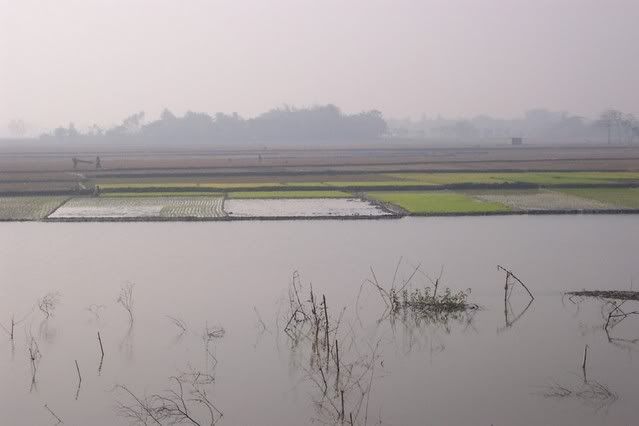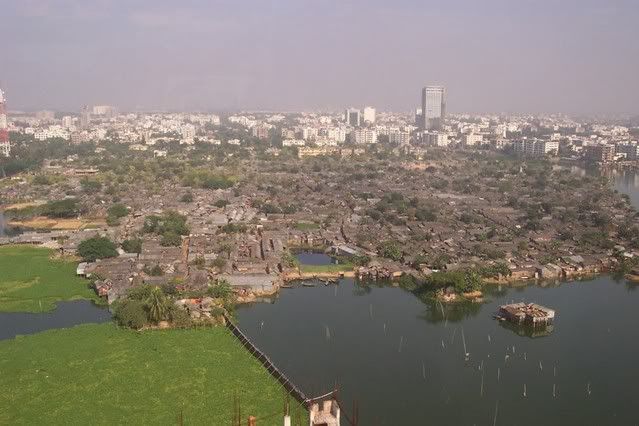As many who follow global warming know, Bangladesh is one of the countries most vulnerable to the potential meteorological consequences of global warming. There are several good reasons why, which I detail below.
This diary serves to give a detailed profile of Bangladesh and what might happen if some of the events projected by climatologists due to global warming come true. Having spent a month in Bangladesh a few years ago, having experienced the genuine kindness and hospitality of many Bangladeshis, and having several friends there now, global warming's threat to the country is somewhat personal for me.
Three major rivers -- the Ganges (known locally as the Padma), the Jamuna, and the Meghna -- course through Bangladesh before emptying into the Bay of Bengal. Composed of, for the most part, the collective delta of these three rivers, the country's terrain (with small highland exceptions in the north and in the Chittagong Hill Tracts in the southeast panhandle) is mostly flat alluvial plain (i.e. low and wet). It has one of the lowest average elevations of any country. (Elevation map)
These geographical conditions place Bangladesh on the edge of the cliff. If the climate model results reported in the New Scientist in 2003 come even close to being true, the land will be pushed over the edge:
Flooding in the country is set to increase by up to 40 per cent this century as global temperatures rise, the latest climate models suggest.Granted, the 40 percent figure is the worst case scenario, but even
[snip]
...heavier rainfall triggered by global warming will swamp Bangladesh's riverbanks, a previously unforeseen effect, flooding between 20 and 40 per cent more land than today, says Monirul Qader Mirza, a Bangladeshi water resources expert now at the Adaptation and Impacts Research Group at the University of Toronto.
...People can grow crops on land regularly fertilised by nutrient-laden silt from the rivers [see photo below]. But extreme floods cause considerable hardship and loss of life: in 1988 and 1998 over two-thirds of the country was under water at some point.
[i]f temperatures rose by just 2 °C, two of the models showed that the mean flow of the Meghna and Brahmaputra rivers would increase by 20 per cent. (New Scientist Article)What will it take to give ourselves a good chance of (but not ensure) avoiding a 2 °C raise and increase the likelihood of sparing Bangladeshis great hardship? According to this seminal article by George Monbiot (related to his new book), it will take a 60% global reduction of greenhouse gases, a 90% average cut by rich countries, and a 94% cut by the U.S by 2030. If this reasoning is even close to the mark, things look really bad for Bangladesh.
The threat to Bangladeshis of a sea-level rise and increased river flooding is exacerbated by its population density, the highest in the world of any sizable country. Imagine half the US population living in Iowa; that's Bangladesh's population density.
When I visited, it was not the monsoon season, when one-third of the country is under water (CIA World Factbook). But even in the dry season, the amount of land available for farming can be scarce in some areas.

(Bru)
This is a view from the Bangabandhu Jamuna Bridge, a massive and modern bridge named after Sheikh Mujibur Rahman, Bangladesh's founding father. (His nickname was "Bangabandhu," or "Friend of Bengal" in Bengali.) The small dots near the sand chars in the middle of the river are farmers in boats. This is a telling example of the shortage of land in Bangladesh: farmers take advantage of any piece of arable land they can get, even if it bears a high risk of flooding and destroying their crops.
A significant rise in sea level may tighten the land crunch beyond repair. According to my Lonely Planet book, "A 1m rise in the Bay of Bengal would result in a loss of 12% to 18% of the country's land" (p. 35).

(Rice nurseries near water's edge - Bru)
Another threat of rising sea levels is infiltration of salt water in fresh water bodies and aquifers. This is especially troubling in a region where half of the tubewells are already contaminated with arsenic.
Already Bangladesh is experiencing an increase in urbanization as the rural poor and environmental refugees flock to Dhaka and other large cities.
Masuma's home is a bamboo and polythene shack in one of the hundreds of slums colonising every square metre of unbuilt land in Dhaka, the capital of Bangladesh.A third of Dhaka's population lives in slums (Source). While there, I learned that future increases in the city's slum population will help make it the world's second-most populous city by 2020.
Masuma is an environmental refugee, fleeing from the floods which have always beset her homeland but which are predicted to strike more severely with climate change.

(Bru)
The grey roofs you see in the foreground all make up one large slum. You can see how it stretches to the edges of the lake, even if the ground doesn't provide a solid foundation. If the migration into Dhaka increases according to projections, where will all these new people live? What will they eat and what water will they drink? These are huge problems that Bangladesh would have to deal with no matter what happens to the earth's climate, but global warming threatens to make them much worse.
Bangladeshis are used to flooding and natural disasters. Besides the normal monsoon flooding every year, they have been hit on occasion by excpetionally bad floods. This happened in 1999, 2002, and 2003 , to name just three recent years. In 1991, a cyclone killed over 130,000 people. In 1970, the Bhola cyclone killed at least 500,000 people, the deadliest tropical cyclone of all time.
In the wake of all these disasters, Bangladesh has improved its response system and disaster planning. But no amount of planning may prepare them for the potential consequences, and ripple effects, of a significant average global temperature rise.
I have been reading parts of Aldo Leopold's A Sand County Almanac lately, and have been marveling at how ahead of its time it is, given that it was published in 1949. In "The Land Ethic," Leopold argues that our ethical systems must evolve to take into account the entire community of life, not just other individuals or human society in general.
In short, a land ethic changes the role of Homo sapiens from conqueror of the land-community to plain member and citizen of it. It implies respect for his fellow-members, and also respect for the community as such.For global warming, we have to fight our subconscious tendency to only pay attention to localized problems, and consider the effect on the global community. We have to treat a threat to people halfway around the world as a threat to our neighbor or ourselves, because that's what we would want people halfway around the world to do if the threat was to us or our neighbor, especially if we knew that our actions influenced this threat.
We don't have to wait for the government to do anything. We don't have to wait for CAFE standards to be raised or for Wal-Mart to sell a bunch of CFLs. We don't have to wait for utilities to add more renewable energy. We can adopt (or cultivate) our own Land Ethic, within ourselves. And if enough of us do this, we might find that we have saved Bangladesh -- not to mention Ethiopia or New Orleans -- from the worst global warming consequences.

No comments:
Post a Comment